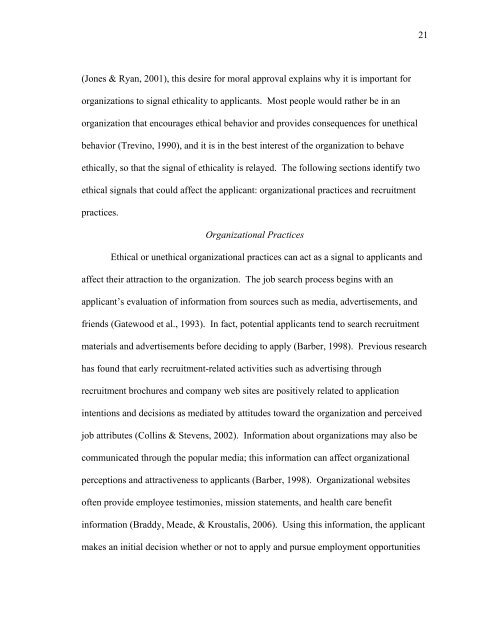THE EFFECT OF ETHICAL SIGNALS ON RECRUITMENT ...
THE EFFECT OF ETHICAL SIGNALS ON RECRUITMENT ...
THE EFFECT OF ETHICAL SIGNALS ON RECRUITMENT ...
You also want an ePaper? Increase the reach of your titles
YUMPU automatically turns print PDFs into web optimized ePapers that Google loves.
(Jones & Ryan, 2001), this desire for moral approval explains why it is important for<br />
organizations to signal ethicality to applicants. Most people would rather be in an<br />
organization that encourages ethical behavior and provides consequences for unethical<br />
behavior (Trevino, 1990), and it is in the best interest of the organization to behave<br />
ethically, so that the signal of ethicality is relayed. The following sections identify two<br />
ethical signals that could affect the applicant: organizational practices and recruitment<br />
practices.<br />
Organizational Practices<br />
Ethical or unethical organizational practices can act as a signal to applicants and<br />
affect their attraction to the organization. The job search process begins with an<br />
applicant’s evaluation of information from sources such as media, advertisements, and<br />
friends (Gatewood et al., 1993). In fact, potential applicants tend to search recruitment<br />
materials and advertisements before deciding to apply (Barber, 1998). Previous research<br />
has found that early recruitment-related activities such as advertising through<br />
recruitment brochures and company web sites are positively related to application<br />
intentions and decisions as mediated by attitudes toward the organization and perceived<br />
job attributes (Collins & Stevens, 2002). Information about organizations may also be<br />
communicated through the popular media; this information can affect organizational<br />
perceptions and attractiveness to applicants (Barber, 1998). Organizational websites<br />
often provide employee testimonies, mission statements, and health care benefit<br />
information (Braddy, Meade, & Kroustalis, 2006). Using this information, the applicant<br />
makes an initial decision whether or not to apply and pursue employment opportunities<br />
21
















